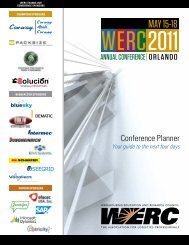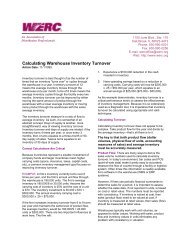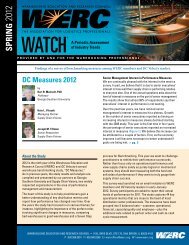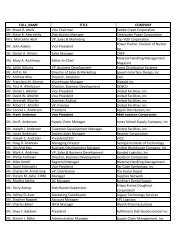Optimizing Inventory Management - WERC
Optimizing Inventory Management - WERC
Optimizing Inventory Management - WERC
Create successful ePaper yourself
Turn your PDF publications into a flip-book with our unique Google optimized e-Paper software.
transportation<br />
Stuck in Place continued from page 1<br />
Not the right time<br />
When the Obama administration first took office, it<br />
jumped right into getting the American Recovery and<br />
Reinvestment Act of 2009 passed. Once it was passed—<br />
and about $50 billion of the $787 billion total was<br />
allocated for transportation infrastructure—there was<br />
plenty of optimism about where the Recovery Act would<br />
lead. Since then, however, the fanfare has died down and<br />
reality has set in.<br />
According to Kavinoky, the administration has been<br />
fairly absent when it comes to taking the lead on infrastructure.<br />
“I can’t really divine what has happened,” she<br />
says. “There are definitely folks in the administration who<br />
understand the issues surrounding infrastructure, but<br />
they may not have a solution to put forward or to<br />
embrace.”<br />
Instead of a focus on infrastructure, says Kavinoky,<br />
the administration has focused on the neighborhood<br />
level with its “livability” initiative. “That’s not a bad thing,”<br />
she says. “But they’re not paying attention to the movement<br />
of goods on a national level.”<br />
When the AARA money first became available, states<br />
had 120 days to obligate it<br />
after the bill passed. Of the<br />
All told, there are<br />
several key bills that<br />
stand in the way of<br />
updating America’s<br />
infrastructure.<br />
$50 billion, $27 billion went to highways and most has<br />
gone to repair and maintenance of existing highways.<br />
While that is, of course, a need, the nation’s infrastructure<br />
issues go far beyond regular upkeep.<br />
There’s also a bit of a tug-of-war taking place for the<br />
dollars. Urban areas are competing directly with rural<br />
and suburban areas for funding of their transportation<br />
projects. Many of the big cities are complaining that they<br />
are being shortchanged because their state DOTs focus<br />
more on state highways than on alternative transportation<br />
projects used in urban areas. The state DOTs argue,<br />
however, that the urban areas will receive funding<br />
through separate streams of the AARA that will bypass<br />
the state government level.<br />
A relatively disinterested Congress doesn’t help matters,<br />
either. “There’s one big thing standing in the way of<br />
passing major legislation, and that’s money,” says Kavinoky.<br />
“There are some big supporters of infrastructure on<br />
Capitol Hill, but it all comes down to the things that need<br />
to move right now and how much money there is to go<br />
around.”<br />
There’s also the current political environment. Many<br />
members of Congress face tough races this year, so<br />
they’re loathe to commit to big issues like infrastructure<br />
“When you look at<br />
Congress and ask who<br />
wants to take the lead on<br />
a tough vote, there aren’t<br />
any takers.”<br />
Janet Kavinoky<br />
4<br />
/ September–October 2010







